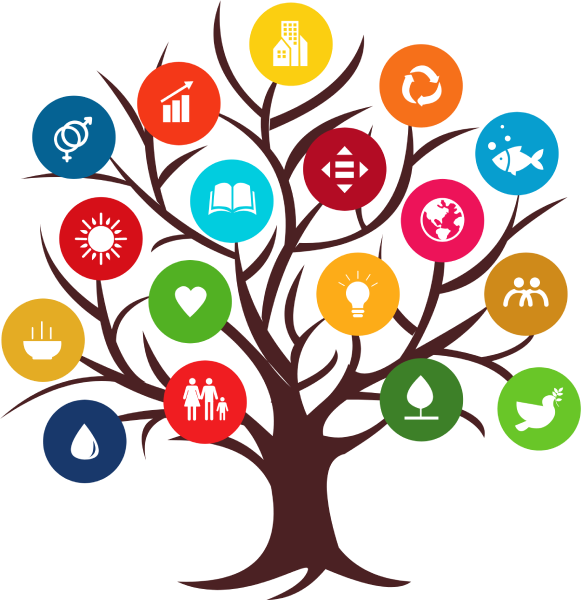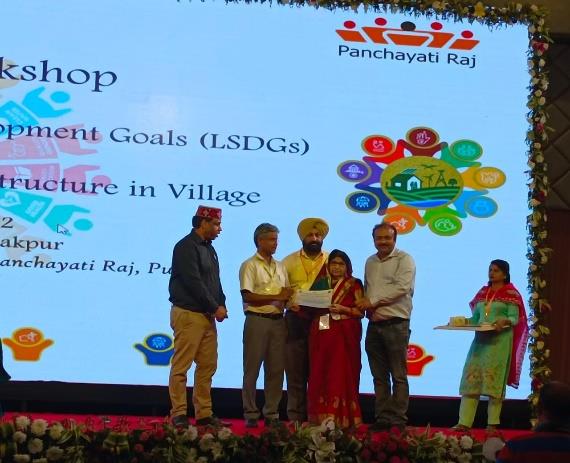
India is a signatory of Sustainable Development Goals (SDGs) 2030 which is a universal call to action to end poverty, protect the planet and ensure that all people enjoy peace and prosperity. Indian model of SDG localization is built around four foundational pillars: (i) creating institutional ownership; (ii) driving competition through collaborative competition; (iii) building capacities; (iv) adopting a whole-of-society approach. Ministry of Panchayati Raj (MoPR) is committed to the achievement of SDGs through the revamped Rashtriya Gram Swaraj Abhiyan (RGSA) Scheme. The RGSA scheme mandates to capacitate elected representatives for good governance through attainment of SDGs through participatory local planning at Gram Panchayat level. The focus of revamped scheme is on reimagining Panchayati Raj Institutions as vibrant centres of local self-governance and economic growth with special focus on Localization of Sustainable Development Goals (LSDGs) at grassroots level adopting 9 thematic approaches as per Niti Aayog.
We foster social cohesion, integration, and sustainability and community empowerment that promotes participation by fostering a sense of community and belonging to the village. It is necessary to mobilize all the opportunities and strengths provided by all stakeholders to promote transformations.
We support Gram Panchayat in balanced use of different renewable, take advantage of local resources and minimizing
the environmental impact and in the territory with transparency, accountability and gender centric social inclusion.
A true embodiment of:
A People, Planet, Partnership Initiative for Prosperity and Peace
Through
Sabka Saath, Sabka Vikas, Sabka Vishwas, Sabka Prayas
9 (Nine) themes have been identified aggregating 17 SDGs for action at local (Gram Panchayat)
level as a way forward for attainment of SDGs by the year 2030
Poverty free and enhanced livelihoods village
Healthy village
Child friendly village
Water sufficient village
Clean and green village
Self-sufficient infrastructure in village
Socially secured village
Village with good governance
Women-friendly village
Panchayats to allocate minimum 50% of untied (FFC/SFC/OSR) resources on the themes on which the panchayat has taken Sankalp as approved by Gram Sabha
The remaining part of the FFC/SFC/OSR can be used on other felt need of Panchayat as approved by Gram Sabha
.png)
Panchayat Development Index
Main Goals Under the LSDG Themes
Comprehensive coverage of all eligible beneficiaries under livelihood and social protection schemes including PDS, ICDS etc
Economic Development & employment generation through individual/ collective enterprise
Eliminate stunting and wasting in 0-6 yrs of child
Zero maternal deaths, child deaths under 5 years.
Provision for medical care and health facilities for all.
100% enrolment in the school.
Reduce Drop-out ratio
Quality Education
100% Immunisation of children
100% child labour free.
No Trafficking cases
Ensure protected environment from all kinds of violence against children
Access to potable water facilities to every household.
Grey water treatment & purification.
Address groundwater depletion, arsenic contamination, rainwater harvesting & groundwater recharge.
100% ODF villages
Solid & Liquid Waste management
Shift from non-renewable to renewable source of energy.
Enhanced green cover through social forestry use of local nursery.
Ensuring conservation of biodiversity and sustainability of ecosystems
Ensure establishment of quality infrastructure - GP Bhawan, AWC, Schools, Health Centre, CSC, separate toilets with running tap water provision in schools.
Ensure all weather connectivity roads, solar street lights and community solar tree, ensure pucca house for all.
Improving living standards of the BPL households
Ensure all weather connectivity roads, solar street lights and community solar tree, ensure pucca house for all.
Ensure social protection through pensions to all eligible
Appropriate infrastructure and facilities for person with disability (Disabled- friendly)
Coordination and convergence among various institutions stakeholders for preparation of GPDP
Involvement of SHG village committees in localization of SDGs
Promoting better public service delivery by use of technology
100% immunisation of pregnant women
Reduce crimes against women and girls.
Improve participation of women in socio-political, economic activities and participation in community- based organisations.
Equal wages for equal pay to the women.
Thematic implemented of LSDGs

1. Poverty free and enhanced livelihoods village
Poverty is a multi-dimensional phenomenon. There are several economic, social, gender and other deprivations contributing to poverty. The problems of poverty and unemployment are inter-linked and need a concrete action plan.

2. Healthy village
Health is a state of complete physical, mental and social well-being and not merely the absence of disease or infirmity. Maintaining and ensuring the health of our citizens ensures the success of all the programmes of the Gram Panchayat and will yield long term dividends.

3. Child friendly village
It is essential to ensure that all children are able to enjoy their rights for survival, development, participation and protection to reach their full potential. Poverty denies children from their fundamental rights to nutrition, health, water, education, protection and shelter.

4. Water sufficient village
Water is essential for human life. Various water sources include rain, streams, rivers, lakes, ponds, open wells, bore wells, tube wells etc. Every household needs water for a number of purposes like cooking, drinking, washing of utensils, cleaning of the house, bathing, washing of clothes, personal sanitation, for household animals and watering plants around the house.

5. Clean and green village
The key initiatives include Open Defecation Free Village, Clean and Green School, Clean and Green Anganwadi, Scientific Management of Solid Waste, Wastewater Management. Village Swachhata Committee/Swachhagrahis take responsibility for Clean & Green village; inspects public toilets, school toilets, solid waste collection in practice, wastewater recycle /reuse. Initiatives in Affordable & Clean Energy like- bio-gas / solar / wind energy for lighting, cooking, or pumping water either by public institutions or at least - a few families, Solar electrification of Sabha Ghar, institutional facilities, households by establishing a 100 KW hybrid solar plant, the installation of charging points to encourage electric transport. Greening Development for tree plantation, tree plantation including fruit bearing trees, Promotion of Organic Farming & Progressive Reduction of Chemicals, Celebrate Clean and Green Living

6. Self-sufficient infrastructure in village
Self-sufficient infrastructure in the village through proper sewage system with closed and covered drains, Sub-centres and PHC with recommended clinical facilities (beds, curtains, etc.), Bus shelter and connectivity to main village/road, Computer and internet facility in the Panchayat Bhawan, Basic infrastructure for providing public services relating to water, sanitation, health and nutrition services, education, women and child development, employment, housing, energy, environment, livestock development, Gender responsive, child and disabled friendly infrastructure

7. Socially secure village
Every person in the village must feel cared for and all eligible must be covered by social security systems. Government has a set of policies and programmes designed to reduce poverty and vulnerability by promoting efficient labour markets, reducing people’s exposure to risks and enhancing their capacity to manage economic and social risks, such as unemployment, exclusion, sickness, disability and old age.

8. Village with good governance
Financial audits, social audits and physical inspections are conducted regularly to ensure transparency and accountability with compassionate responsibility/responsiveness and maximum cooperation/participation of citizens. The Gram Panchayat has actively involved weaker sections through self-help groups and serves as an exemplary model of participatory decision-making and ensuing development through good governance. Discharge all responsibilities dutifully especially in providing basic services to all citizens through Time-bound service delivery

9. Women friendly village
The Constitution of India envisages a discrimination-free India. Without ensuring gender equity and equal rights for women, social and developmental disparities cannot be eradicated. Gender equality is not only a fundamental human right, but inevitable for a peaceful and sustainable future. The exclusion of women places half of the world’s population outside the realm of opportunity to partner in building prosperous societies and economies. Equal access to education, decent work, and representation in political and economic decision-making processes are not only rights women should have, they benefit humanity at large.

A People, Planet, Partnership Initiative for Prosperity and Peace
Through
Sabka Saath, Sabka Vikas, Sabka Vishwas, Sabka Prayas


